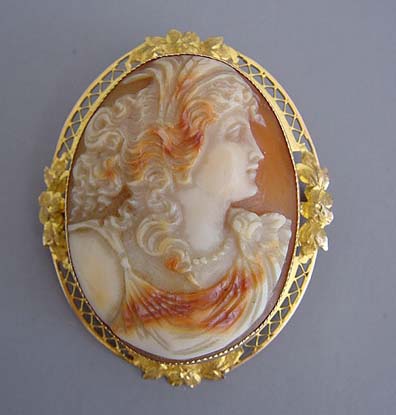Cameo
Basically, cameo is a method of carving, or an object such as an engraved gem, item of jewellery or vessel made in this manner. While the exact origin of the first cameo is unknown, the style dates back to ancient Greece and Rome when cameos depicted morals and themes from mythology. Cameos came back into fashion largely through the interest shown in them by Empress Josephine, Napoleon’s first wife. Her jewelry collection included several cameo tiaras, one of which is still owned by Sweden’s royal family today. Throughout the subsequent generations, the cameo has been transformed into a delicate form of art and treasured piece of jewelry. The antique cameo jewelry we value today usually features intricately carved profiles.
During the Victorian Era, (1837-1901) every decade had its jewelry trends, but the cameo remained a favourite. And interestingly, the intaglio, which was a piece carved below the surface, came before the cameo. In ancient times, the intaglio was used to seal papers or to mark property. Later on, it became a jewelry item worn by women. The cameo is the opposite of the intaglio. It is a portrait or scene carved in relief with a contrasting colored background. In the Nineteenth Century, skilled artisans utilized gemstones, stone, shell, lava, coral and manmade materials to produce cameos.
Cameos are made from a variety of materials. Mother-of-pearl, coral, agate, and more than 25 types of shells are all commonly used because of the availability and the ease with which they can be carved. Much of the world’s hand-carved, antique cameo jewelry comes from the small town of Torro del Greco, located on the Bay of Naples in Italy. The craftsmen in this town use a carving style that dates back thousands of years to create unique, ornate pieces that are used in many forms of jewelry.
Discoveries of archaeological sites in Italy and Egypt renewed an interest in the classics that influenced cameos of the Victorian Era. Motifs included gods and goddesses from mythology and other subjects related to them, such as Bacchante maidens adorned with grape leaves in their hair, the Three Graces, who were the daughters of Zeus, and Leda, a woman shown feeding Zeus and more.
Cameos are set in a variety of jewelry styles, creating unique pieces that often become family heirlooms. Cameo brooches were a common fixture on the collars of women during the Victorian era. Because many antique cameo brooches often feature both a pendant bale and a pin, many antique cameo necklaces are actually brooches worn on a chain as a pendant.
For the past 25 years, carvers in Germany have produced cameos using the laser technique. It may feel rough to the touch. To learn about cameos, it is important to handle them. This allows the collector to feel, and tap them slightly against the teeth to identify whether they are made of stone, shell or other materials.
